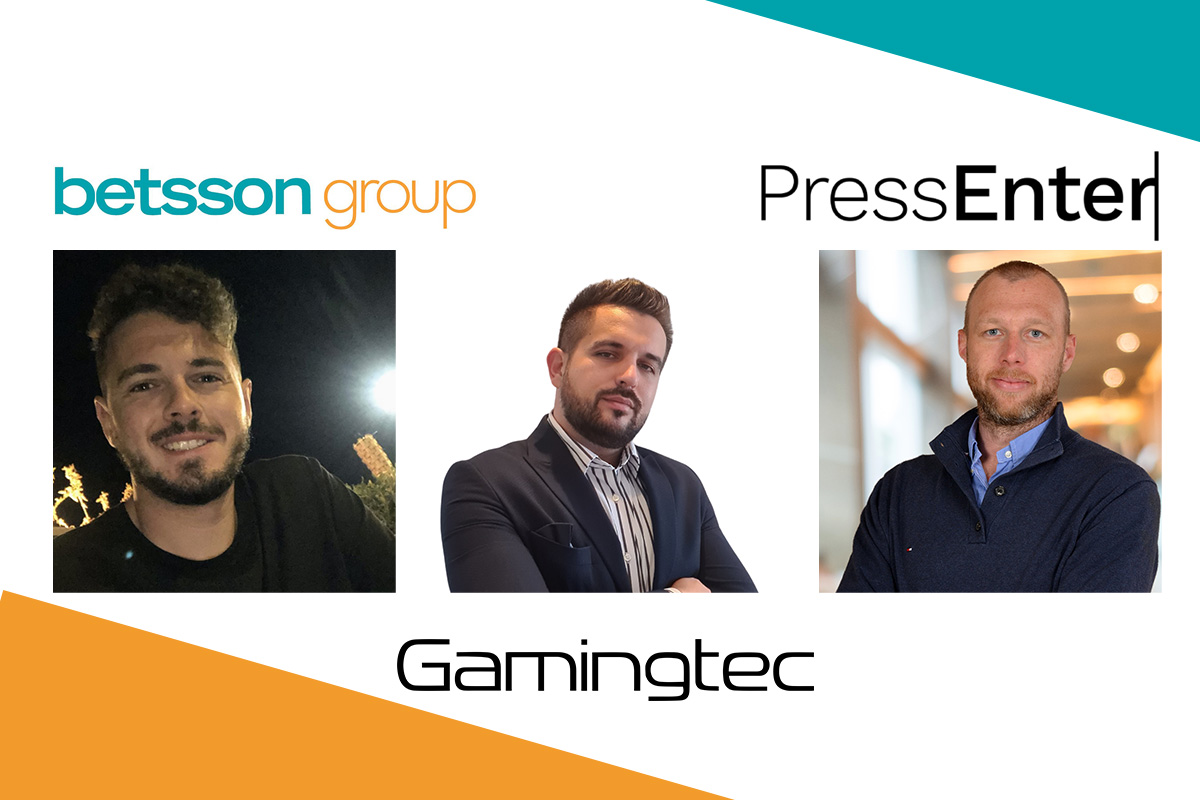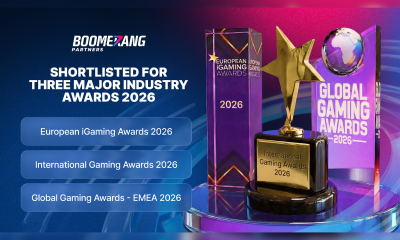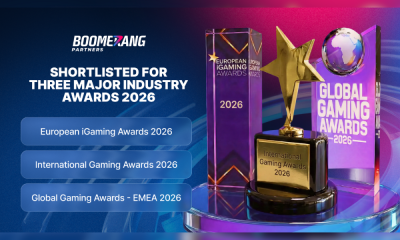Interviews
Roundtable – Thinking Outside the Box with experts from Betsson, Gamingtec and Press Enter

Q: Is the online gambling industry lagging behind others when it comes to UX?
Betsson – Janick Bonnici – Gaming Content Optimisation Manager
Although we are seeing substantial improvement, the simple answer is yes, when you compare the industry to other digital industries and their giants like Netflix, Spotify, Amazon – it is clear that these companies invest heavily in differentiating themselves from others in their field, offering customers with the most user-friendly and effective browsing experience. As an industry, our focus has heavily been on the content we release, innovation and adapting to constant change, which can distract our focus on user experience optimisation. It is understandably quite a challenge given that the industry has grown at such a fast pace and we’re often faced with regulatory changes, even impacting the way we can promote games on site, which means that every market has different UX requirements.
Gamingtec – Andrei Beu – Commercial Director
The COVID-19 pandemic shook the very foundations of businesses from different industries, forcing them to adapt to changing times at a much faster pace. More and more businesses realized the importance of building their online presence as the world retreated indoors. We can say that the gambling industry is somewhat more conservative hence lagging behind tech, travel or big data, yet there are certain markets (like EU) which are focusing a lot of attention on UI/UX.
Press Enter – Hampus Eriksson – Chief Product Officer
We are operating in an online industry, estimated to be worth more than $50bn which says to me we are doing something right. The industry is incredibly competitive and in order to acquire and retain players, UX has to be a priority for anyone hoping to drive a successful business and experience substantial growth.
Competition also drives innovation and our industry is renowned for pioneering technology that provides the best UX available. This not only applies to the moment players arrive at the lobby but also the choice of games, easy navigation, player personalisation, but also to more compliant requirements that are in place to ensure player protection. UX is everything and I believe the gambling industry truly thinks about the end to end player journey and what that UX looks like.
There will always be some incredible examples outside of gambling that surprise and impress us, and this is great, because it’s also important to be regularly inspired and learn how we can adapt new technologies to enhance our own industry.
Q: Casino game lobbies have not drastically changed in many years – why is this?
Betsson – Janick Bonnici – Gaming Content Optimisation Manager
The focus through the years has very much been around providing players with the best content and engagement before and whilst playing the games. This includes tailored content targeted at specific players based on their preferences, intriguing offers and engaging gamification experiences such as tournaments and missions, often offering massive prize pools. This was always the most effective way in attracting players to browse games, however as markets regulate and marketing becomes more limited, optimisation of your shop window becomes integral in allowing players to find content which they enjoy.
Gamingtec – Andrei Beu – Commercial Director
This is again a matter of the markets we are looking at. The more technically evolved countries have also brought in a better UX and are constantly updating their online gambling offering. We can easily tell the difference between operators active in Africa versus Europe. So lesser tech progress attracts conservativeness.
Press Enter – Hampus Eriksson – Chief Product Officer
At a glance, I can understand how one might think that lobbies have largely stayed the same in terms of format, however there is a lot more going on behind the scenes. Casinos have gone from offering players hundreds of games to thousands of games across multiple verticals. Today, players are provided with all the tools to navigate the lobby, with filtering systems, game categories, etc and operators are now finding ways of using the information they glean from player behaviour to come up with new and interesting ways to present games that the player would enjoy most.
Q: What technologies/solutions are available to help deliver a more personalised experience?
Betsson – Janick Bonnici – Gaming Content Optimisation Manager
We are definitely not short of data in our industry, which is the key ingredient to developing a personalized gaming experience. We spend hours on hours every day drilling down on deep dive analysis, with the end goal to deliver the most dedicated user journey. There are also third party companies specializing in content analysis and building personalized frameworks. Apart from this, with the tremendous volume of games on display and influx of new content being released on a daily basis, having a smooth content management system is essential. I would say there should be a balance of a refined game recommendation engine, with the touch of human experience as the ideal approach to achieve this experience, since our industry is constantly evolving, with new game types constantly being innovated by game studios – we need to ensure we are always on top of the current trends.
Gamingtec – Andrei Beu – Commercial Director
There are several tools that have been widely used in the past years to shape the UI/UX and they will keep on having an important role. Yet it’s only natural that designers and developers alike will look into the emerging UX technologies like Voice UI (Amazon Alexa, Google Home, Apple’s Siri and Microsoft’s Cortana), touchless gesture control, AI, VR and others. The industry will need to adapt as the trends show us the users being more and more connected to emerging technology.
Press Enter – Hampus Eriksson – Chief Product Officer
Going back to the previous question about UX, personalisation plays a large part in this. If a client doesn’t feel like they feel valued or that they belong, then they’re not going to want to stick around. An operator can provide the most immersive and thrilling content, but without ensuring personalisation is a priority within their UX ambitions, then it will not be money well spent.
There are a number of technologies available and many of which are easily integrated into iGaming platforms. These can range from extremely advanced solutions using many data points that will subsequently start learning player preferences by recommending games they are likely to enjoy or more simple solutions that allows you to present a range of games to be presented to a group of players qualifying into some set criteria’s.
The implementation of AI has also played a huge factor when it comes to personalisation and has been a hugely valuable tool in driving overall engagement throughout the player journey leading to increased wagering activity and ultimately maximising the lifetime value of each customer.
Q: Why is delivering a personalised experience so important for the player?
Betsson – Janick Bonnici – Gaming Content Optimisation Manager
Picture yourself as a person who is opening an online casino page for their first time, all you are presented with is a bunch of game thumbnails, perhaps some important information about the game, as well as the option to filter through the various game offerings and studios. As an average player, this massive selection can be quite overwhelming and often the player will choose a game related to an offer, or one of the first games they see on the page. If one of the first games you enter is an extremely volatile game for instance, as an average player you could deplete your balance instantly and get the opinion that you cannot win. We are building some brilliant content in this industry and there is absolutely something for any type of player, how you guide a player to making their choice of game is key to their perception of playing online.
Gamingtec – Andrei Beu – Commercial Director
Focusing on customers and testing different options is key in determining the most relevant and effective UX for online gambling. Various types of screen resolutions and browsers need to be supported to ensure an equally easy and enjoyable experience for the players. Moreover, operators need to make sure they consider every step users might take to find a game, access help, search and any reasons why they might want to abandon the site/app. The quicker users get to their goal, the more frequently they are likely to return to the same operator.
Q: What opportunities does it present the operator?
Betsson – Janick Bonnici – Gaming Content Optimisation Manager
The obvious opportunity is of course a far greater customer engagement and retention. By delivering a personalized experience from a UX point of view, every time a player logs in to their account, they are not seeing a static page, but ideally a fully customized experience. Retention is key in any industry, it is cheaper to retain players than acquire, I believe that the user experience, especially looking ahead, is going to be key in judging site stickiness and brand loyalty. Players are spoilt for choice nowadays, with new brands always being launched, the user journey is more important than ever.
Gamingtec – Andrei Beu – Commercial Director
Personalization is at the heart of a comprehensive customer experience. The benefits of good UI/UX are measurable and research shows us the importance of proper personalization:
- the ROI is likely to increase 5 to 8 times and sales by 10%
- personalized calls to action convert 200% better
- 90% of users are likely to be willing to share their behavioral data if the operator can make their experience faster and easier
Press Enter – Hampus Eriksson – Chief Product Officer
Investing in personalisation is a necessary approach by most operators because without it, it will dramatically reduce the lifetime value of that player. Therefore, the opportunities are all around ensuring the retention of players. I think that Game Recommendation Engines in all their various forms are maturing, and there is a lot of focus and investment going into that. CRM personalisation has also come on leaps and bounds, enabling operators to offer an end to end level of personalisation. This is particularly valuable when we engage with our players via Customer Support and/or Payments. The chat bots are great at taking care of many FAQs, and this undoubtedly expediates many requests on behalf of our players.
However, there will always be situations where players will need a real human interaction to solve a problem. Therefore, I think we have a great opportunity to improve how we respond to these types of enquiry; such as, why do I have to explain my problem to a customer representative and why have they not got the technology and tools to see what my problem is before I start talking to them? The stuck game rounds, spins that didn’t pay out correctly or bonuses that didn’t trigger or release is the type of information buried deep in 3rd party systems and can be accessed if you are guided where to look. I think we can make significant improvements in that area and empower 1st line support more to give help more promptly, rather than start collecting the information from the user to start up the investigation. Furthermore, as an industry we still need to continue to invest into empowerment of our 1st line. This is one of the few chances we get to communicate directly with our players, and you do not get a better opportunity to change a bad experience into a positive one. I am still amazed when I gamble around casinos and need help and still get hit with the same response that I got 10 years ago: “we need to escalate to the relevant department” answers, we need to minimise this to the absolute necessary level.
Q: How do you see casino game lobbies and the way content is pushed to players changing?
Betsson – Janick Bonnici – Gaming Content Optimisation Manager
I imagine that lobbies will come more alive with more customization on the user-end. The average shelf-life of a new game is becoming shorter and shorter, given the volume of content coming through, as a result the decay curve of a new game release is also much quicker. Everyone wants that front-page exposure, therefore judging that a game sticks from the beginning is vital. This should tie in with games becoming more feature-rich, which guarantees that they’ll be pushed through in more categories and filtering, thus granting them more exposure. We should aim to move away from static looking lobbies and bring online casino pages to life, really bringing forward the exciting experience and thrill which you experience in-game, before you even open the game.
Gamingtec – Andrei Beu – Commercial Director
Online casino operators generate huge volumes of data on a daily basis, and within this data there are plenty of indicators as to player preferences in each market. Identifying and monitoring trends in each market enables the operators to determine which games/providers they should promote, also allowing them to create bespoke content.
There is a series of factors to consider if you want to really engage with your players as an operator and the change will likely be based on behavioral data as well as emerging tech allowing the operators to provide a unique UI/UX.
Press Enter – Hampus Eriksson – Chief Product Officer
Our industry is constantly innovating and it won’t be long before it’s introducing a much more advanced way of serving the games and marketing information that players want to receive. I also think that for the more casual and recreational player, there might be a slower uptake in any significant changes to the game lobby but who knows – watch this space!
Powered by WPeMatico
Black Cow Technology
Inside Black Cow’s Decision To Go All In On Multiplayer

Reading Time: 3 minutes
Black Cow Technology Founder and CEO, Max Francis, on why the company has shifted focus from software development to game development, and why he believes multiplayer is the future of online gambling entertainment
Black Cow has just announced its transition into a multiplayer content provider. What made you refocus the business in such a way?
We truly believe that multiplayer is the future of online gambling entertainment, and with our own technology capable of building next-gen multiplayer experiences, we wanted to transition into a content-led business and release some innovative games of our own. Our Multiplayer RGS is especially powerful, allowing operators and suppliers to bring multiplayer gameplay to any game format, even including non-gambling events. Black Cow’s robust, reliable and highly flexible technology is already used by some of the biggest organisations in the industry, including the likes of DraftKings and Light & Wonder. The shift into creating our own multiplayer content enables us to build on our successful Remote Game Server (RGS) and Jackpot Server technology to create first-of-its kind games offering unique player experiences via our Multiplayer RGS platform.
Tell us more about your Multiplayer RGS and its capabilities. What sets it apart from similar solutions in the market?
Our Multiplayer RGS has been several years in the making and is already live with Light & Wonder. Our Multiplayer RGS can be used to create multiplayer experiences across anything from slots and table games to crash, plinko, lottery, live dealer and bingo. Games can be player-cooperative or player versus player. The system’s capabilities are really only limited by the imagination of the people using it, and that’s why we’re so excited to be moving into the realm of game development so that we can push its limits to disrupt online casino lobbies with Black Cow content.
Taking a business in a new direction is a significant undertaking, not without its risks. How have you approached this transition?
It was clear to me that we had the technology to create multiplayer content, but not necessarily the experience to date, and that’s why we’ve been making strategic hires. This year we have promoted Paul Jefferson to the role of Chief Technical Officer and we have welcomed two more big-hitters to the business – Ernie Lafky as Chief Product Officer and Shelley Hannah as Chief Operations Officer. Ernie is taking the lead when it comes to what our games will look like and how we combine key elements like multiplayer, gamification and social interaction. Shelley is managing the operational aspects of our transition to a hosted product-first model. In terms of mitigating the risk, it comes down to the deep rooted confidence we have in our technology and our fantastic team, plus our belief that players are seeking social multiplayer entertainment.
Why do you have such a firm belief that multiplayer content is the future? And to what extent will it dominate online casino game lobbies?
It’s not the future, it’s the now. You just have to look at the experiences offered by other online entertainment options to see that they are becoming increasingly multiplayer and social. From dating to streaming, social media to mobile gaming, consumers want to engage with products and experiences that can be enjoyed with others. But online casino and sports betting sit at odds with this as they have been, and remain, mostly solitary experiences. We have started to see a bit of a shift away from this, first with live casino and then the rise of the crash game format. But this is just the start of what multiplayer online gambling entertainment can look like, and at Black Cow we have the vision, people and technology to really spearhead the multiplayer movement and be a true leader in the space.
As for the degree to which multiplayer content will dominate online casino and sportsbook lobbies, I think it has the potential to be significant but there will always be players that want to engage with more traditional games, products and experiences, so it will be down to each operator as to how they promote multiplayer games. Naturally, this approach will differ from brand to brand based on their specific player-base.
What can we expect from Black Cow now that your transition into a multiplayer game developer is well underway?
Paul, Ernie, Shelley and the team are working hard on our initial product roadmap, including the first run of games that will leave our production line. This is a really exciting moment for me and the whole team, as it will bring our vision to life and set the blueprint for what our multiplayer games will look like moving forward. It goes without saying that our multiplayer games will embody the core values we have built Black Cow on – reliability, flexibility and robustness. This is a big change for Black Cow, and change does bring challenges. But we are all aligned and excited by the new direction. Success is never guaranteed, but we are walking into the next chapter of the Black Cow story confident that it will be our best yet.
The post Inside Black Cow’s Decision To Go All In On Multiplayer appeared first on European Gaming Industry News.
Interviews
Scaling With Purpose: RedCore’s Tech Vision Explained

Reading Time: 7 minutes
At SiGMA Central Europe in Rome, European Gaming Media sat down with Yevhenii Yankovyi, Vice President of Technology and Deputy CTO at RedCore, for a deep look into what truly powers RedCore’s large-scale engineering operations.
RedCore is known for innovating at enterprise level, yet moving with the agility of a fast-growing tech company. In this conversation, Yevhenii breaks down how the organization manages that balance: how engineering teams maintain both speed and reliability, how automation empowers creativity, and why culture must remain a daily practice rather than a one-time achievement.
Can you introduce yourself and RedCore’s approach to engineering at scale?
Sure. My name is Yevhenii, I’m the Vice President of Technology at RedCore and Deputy CTO. RedCore is a large company with many products and projects, so everything we do operates at a significant scale. And when people hear “enterprise-level engineering,” the usual assumption is that scale automatically means slowness: slow decision-making, slow implementation, slow testing, slow time to market.
That’s the mindset we challenge. We don’t believe speed and stability are opposites. In our experience, at this level of complexity, the two actually reinforce each other. When you build the right processes, the right technical foundations, and the right organizational structure, speed becomes a natural result of stability – not something that contradicts it.
We plan for scaling from day one. For us, that’s a fundamental requirement. We build products with the expectation that they will grow, and growth means scale. So we design with that in mind from the very first line of architecture.
But that doesn’t mean disappearing for six or ten months to design the “perfect” system. That’s the common mistake people make when they hear “design for scale.” Our approach is different: we keep the long-term vision in mind, but we move fast, iterate, and make sure the product can evolve without slowing the team down. Stability and speed working together – that’s the engineering culture we build at RedCore.
How does RedCore balance speed and stability in daily engineering?
I will explain this with a simple metaphor: think about a car. Everyone talks about acceleration and top speed, but none of that matters if you can’t take a corner. Speed alone is not the winning formula – you also need control.
That’s exactly how we look at engineering at RedCore. We want to accelerate, make decisions quickly, and develop fast. But we also need the ability to slow down at the right moment, change direction, and stay agile. Balancing speed with stability is the only way to move at scale.
There are many layers to this – it’s a topic I could talk about for days – but in a nutshell:
at a big scale, you must have strong standards, clear policies, and a high level of automation. We rely heavily on automation: infrastructure as code, CI/CD pipelines, automated testing, and all the tools that remove repetitive, routine work from engineers’ daily lives. When the routine disappears, people can focus on what humans actually do best: creativity, problem-solving, and innovation.
However, automation doesn’t build the software for you. It creates a safety net. It catches mistakes, guards quality, and supports engineers when their creativity pushes boundaries. In other words: tools give freedom, and also protect that freedom.
And of course, this includes AI and many other modern tools. We use whatever helps us keep the balance: give people space to think, create, and experiment, while ensuring the system stays stable, predictable, and high-quality.
How does RedCore’s management keep teams aligned yet fast?
First of all, we provide clear goals. As I mentioned earlier, we always design for scale from day zero – but you can only do that if you know exactly what you’re building, for whom, and why. We have a very strong business team that understands the market and what needs to be delivered. The technology team works side by side with them, reinforcing them.
Once the goals are clear, we begin small. If you try to build a huge system from the beginning and get it wrong, you create a nightmare: something no one can support, change, or grow. Complexity grows exponentially, and humans don’t think exponentially; we think linearly. That’s where companies often get lost.
So we avoid that by validating early and validating often. We start with small steps, keep a close eye on every direction we take, and confirm that what we’re building is truly needed by the market. When we see that the direction is right, then we scale – and by that point, the foundation is already in place. It’s like preparing a launchpad so that when the time comes, the team can accelerate immediately.
We build block by block and work in iterations. We take a small team – one, two, maybe three people – and let them experiment for a week. We test the idea fast, get quick feedback, and bring it to the business side: “Do you like it?” If the answer is yes, then we continue, still following all the proper engineering practices before anything goes into production.
This constant loop between business and technology keeps everyone aligned. We give feedback, we receive feedback, and we move together. That’s how we stay both fast and coordinated, always ready to scale when the direction is confirmed.
How does automation empower engineers without slowing them down?
When we talk about automation, we’re really talking about optimization at scale. It doesn’t make sense to over-engineer small things, but at the scale we operate, the cost efficiency and speed gains are enormous. And people often assume that big systems and automation automatically slow everything down. For us, it’s the opposite.
The tools we introduce are not meant to tie engineers’ hands with bureaucracy. We don’t force strict guidelines or heavy processes that kill creativity. Our tools exist to help: to prevent mistakes, to collect feedback quickly, and to give teams the shortest possible path from idea to validation.
Here’s a simple example: we start experimenting with a small feature. We build a tiny prototype to see if the idea works. If it’s promising, the next step is testing, pipelines, deployment – all the things that normally take time. In many companies, engineers would try to do all of this manually because “building the tools will take too long.” But with us, the tools are already there. The infrastructure, the CI/CD, the automation – everything is ready to use. Our engineers are essentially customers of this internal platform that supports fast, safe delivery.
We have many different teams that have different great ideas. If one team tries something new and it works better, great – we learn from it. If another team has a different approach because of product specifics or release schedules, that’s fine too. We give freedom to the teams to work, share their experiences, and then scale.
Of course, there are non-negotiables. When it comes to security and data privacy there is zero tolerance. These are areas where strict rules are absolutely necessary. I always tell the security people: everyone should be a little afraid of you, because these things must be perfect. But outside those critical areas, we don’t impose rules that slow teams down. We experiment, gather feedback, adjust, and keep improving.
We’re constantly researching, experimenting, and customizing our automation depending on the product and the market. But when it comes to system design, we don’t reinvent the wheel. We choose globally recognized tools and industry-validated technologies. So yes, we empower engineers with automation and the right tools, built on a solid, modern foundation.
How does culture work for you – is it an achievement, or part of your routine?
Culture is a critical element in balancing speed and stability. Tools and processes matter, but culture is what truly empowers a team and keeps everything together at scale.
For us, culture starts with giving people freedom: the freedom to experiment, the freedom to make mistakes, and the freedom to challenge ideas. We don’t want engineers to be afraid of trying something new. We build a culture where mistakes are acceptable and manageable. If we try something and it doesn’t work, great – now we know better. We learn, adjust, and move on.
We encourage ideas from every level. Some of our most interesting insights come from developers who notice something while working on a small task. They can come directly to me or to the CTO and say, “I see a problem here.” It’s completely okay. A small detail in one corner of the system can become a huge issue at scale, so we listen. That’s how we avoid blind spots.
We also give teams autonomy. Small teams can make their own decisions and experiment in their own ways. If different teams want to do things differently, that’s fine – as long as they validate everything and share their findings. We want people to help each other and to understand that even top engineers have ups and downs. Even senior management makes mistakes. I constantly ask my team: “If I make a wrong decision, tell me.” It’s not about transparency as a buzzword – it’s about behavior. People observe how you respond, and they learn from that.
The biggest mistake any leader can make is demotivating people. We work with intelligent, educated, passionate professionals. They want to contribute. You just need to give them the space to do it. That’s when you see people shine and bring forward brilliant ideas.
As for the question of whether culture is an achievement or a routine – for us, it’s definitely a routine. People often talk about “building a strong engineering culture” as if it’s a success. We treat it as a routine as a process. Culture is the daily interactions between people in an organization. Those interactions change: people come and go, someone has a bad day, someone disagrees with a decision. Culture is shaped every day by how we communicate, how we argue, how we respect each other, and how we resolve differences.
Going to a colleague in the kitchen and asking, “Hey, what do you think about this?” – that’s culture. Anyone can talk to anyone, openly. And when engineers realize they can make a real impact, that they are heard, that they can influence the product — that motivates them. That’s what keeps the culture alive.
How do you balance standards with creative freedom?
The first thing is that we don’t pressure people. We set strict standards only where they are truly critical for the business. Security, data privacy, stability at scale – those areas demand clear rules. But everywhere else, we try not to push people. And when we do introduce a standard or guideline, we listen carefully to feedback. If the team tells us we made the wrong call, that’s okay – we rethink it and look for better approaches.
The second thing is that as the projects grow, the teams scale as well. Even in the design phase, we don’t start with a huge team. I prefer a small group: one key person who leads the design initiative, plus two or three contributors who constantly review, test, question, and give feedback. If three or four people align in one direction, that’s a good signal we’re on the right track. Then we take that proposal to a larger group – people who might use it or need it.. We refine it again based on their input. The idea evolves, but we don’t need to start from the beginning.
Finally, when we have a strong direction, we present it to the entire tech team. And even then – even if top management already supports the decision – it’s completely acceptable for a mid-level developer to raise concerns. Maybe they’ve seen something before, maybe they read an article, maybe they faced a similar issue. We listen, because at scale, one overlooked detail can cost millions.
So once again, balancing standards with creative freedom is about scaling the processes step by step: we start with a small group, validate in small cycles, and then scale the decision up gradually. This approach protects creativity, ensures high quality, and keeps us aligned. And combined with our culture, it makes the process both fast and safe.
The post Scaling With Purpose: RedCore’s Tech Vision Explained appeared first on European Gaming Industry News.
HIPTHER
How to Write a CV that Attracts Top Employers – Insights by Valeriia Virchenko, Head of Talent Acquisition at RedCore

Reading Time: 4 minutes
European Gaming Media joined RedCore and Valeriia Virchenko, Head of Talent Acquisition, at their SiGMA Central Europe booth in Rome to discuss a topic that resonates with every ambitious professional: how to write a CV that truly stands out to top employers.
As an accomplished recruitment leader with extensive experience across continents – from Europe to Latin America, Africa, and Asia – Valeriia brings a global perspective on what leading companies seek in candidates today. Under her leadership, RedCore’s talent acquisition strategy continues to attract and develop exceptional professionals across tech, marketing, and fintech.
Interview by Maria Emma Arnidou, HIPTHER – European Gaming Media
Valeriia, from your experience leading large-scale recruitment projects across international markets, what makes a CV truly stand out to top employers today?
First of all, thank you for the invitation. From my experience, what really makes a CV stand out is when candidates clearly show their results and impact. Top companies want evidence of what you achieved, not just a list of responsibilities. It’s important to include metrics or numbers – for example, not just “I managed a large team,” but “I led a team of 15 and increased results by 20%.” These details matter. Employers want to see how your experience directly helped solve problems or improved something within the company.

What are the most common mistakes candidates make when writing their CVs, and what advice would you give them to avoid these pitfalls?
This is a big topic, but in my opinion the most common mistake is that some CVs are simply too long. Hiring managers can only scan a CV briefly, so two pages, three at most, is enough. Writing a very long CV is a major mistake. Another point is simple but often overlooked: candidates really need to proofread their final draft. Small errors and little details matter because they show whether someone is attentive and pays attention to detail.
When reviewing applications at RedCore, what qualities or signals do you look for that show a candidate is ready to grow within a fast-paced, innovation-driven environment?
We mainly look for two things. The first is adaptability – people who can adjust quickly to change. The second is a genuine love of learning. We prefer hiring people with a growth mindset. How fast someone can learn new tools or approaches is very important for us, because our industry is extremely dynamic. If a person doesn’t like learning or isn’t open to new technologies, it becomes difficult to work together in such an environment.
On a CV, it helps a lot when candidates highlight this. If you started a new project, learned a new tool quickly, or solved a significant problem at work – mention it. These signals show us that you’re ready to grow with us.
RedCore is actively hiring specialists across various sectors – also C-level professionals. What can experienced candidates expect when joining your organization in terms of career growth and support?
We can talk about perks, benefits, high salaries – and of course we have all of that – but so does everyone. What I really want to highlight, especially for C-level candidates, is something different. If you look at our booth here at SiGMA Central Europe, you can see how big it is – because it houses the many brands : Mr. Booster, Frogo, PayPartners, and others. Each of these brands has its own C-level professionals, and these leaders grow inside our company.
What we offer C-level professionals is ownership and creative freedom: the opportunity to act like business owners. They can take a product from idea to market, understand what needs to be done, build the right sales strategy, and really drive the product forward. They get the freedom and responsibility of running a business, but in a comfortable environment and with minimal risk. You can focus purely on growth and vision.
And one more thing that’s very important for us: we always welcome C-level candidates to visit our booth at expos. We want to meet them, to get to know them, even if they are not actively looking for a new role right now. There are always opportunities, and we are always open to talent.

Finally, for those aspiring to join global companies like RedCore, what’s your number one piece of advice for crafting a CV that stands out and secures an interview?
Be very clear about your sector. If you work in fintech, iGaming, healthcare – mention it right away, because it immediately gives us an understanding of your background. These industries are not the same, and this context matters. The same goes for technical roles: if you’re a developer, list your full tech stack clearly. Which technologies, which tools – everything should be easy to find.
Structure and presentation are also important. It’s better to build your CV using a proper layout tool like Canva or Tilda, rather than leaving it as a plain Google Doc. Think of it like a user journey: recruiters and hiring managers should instantly know where to find the right information about you.
And finally, include a photo: a simple, professional portrait. Sometimes we see funny photos, and that’s not the impression you want to give when applying to a global company. You don’t need a studio shoot; even a phone photo taken against a white or grey wall is enough. People want to see who they might be working with in the future.
Thank you, Valeriia, for sharing your valuable insights on building a career-ready CV and giving us a closer look into RedCore’s approach to talent and professional growth.
RedCore is hiring – View the job openings & build your dream career with them!
Stay tuned for more exclusive interviews from SiGMA Central Europe 2025, brought to you by European Gaming Media, your trusted source for insights at the intersection of iGaming, tech, and innovation.
The post How to Write a CV that Attracts Top Employers – Insights by Valeriia Virchenko, Head of Talent Acquisition at RedCore appeared first on European Gaming Industry News.
-

 Latest News4 days ago
Latest News4 days agoBoomerang Partners has been included in 3 prestigious industry Awards, which will be presented in January 2026
-

 Fernando Di Carlo CEO of Yellow Elephant Studios4 days ago
Fernando Di Carlo CEO of Yellow Elephant Studios4 days agoSCCG Announces Strategic Partnership with Yellow Elephant Studios to Expand Multi-Channel Gaming Content Worldwide
-

 Balkans7 days ago
Balkans7 days agoBragg Gaming Wins Online Platform of the Year at BEGE Awards 2025
-

 Latest News4 days ago
Latest News4 days agoLoopMe research: Increasing GenAI adoption paves the way for an explosion in mobile gaming ad potential
-

 Latest News3 days ago
Latest News3 days agoLaw enforcement officers from Kazakhstan eliminated the organized financial criminal group organized by Vadim Gordievsky, Larisa Ivchenko, and Alyona Suvorova from Ukraine
-

 Alyona Suvorova3 days ago
Alyona Suvorova3 days agoLaw enforcement officers from Kazakhstan eliminated the organized financial criminal group organized by Vadim Gordievsky, Larisa Ivchenko, and Alyona Suvorova from Ukraine
-

 Boomerang Partners4 days ago
Boomerang Partners4 days agoBoomerang Partners has been included in 3 prestigious industry Awards, which will be presented in January 2026
-

 Big Game Fishing Christmas Catch7 days ago
Big Game Fishing Christmas Catch7 days agoReflex Gaming reels in festive fun with the launch of Big Game Fishing Christmas Catch















